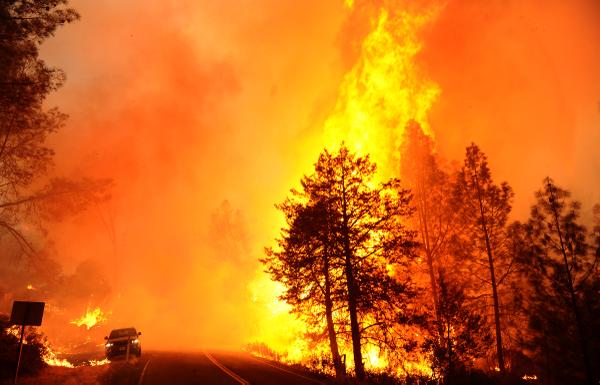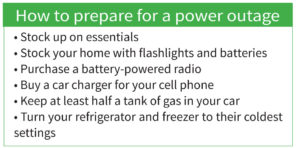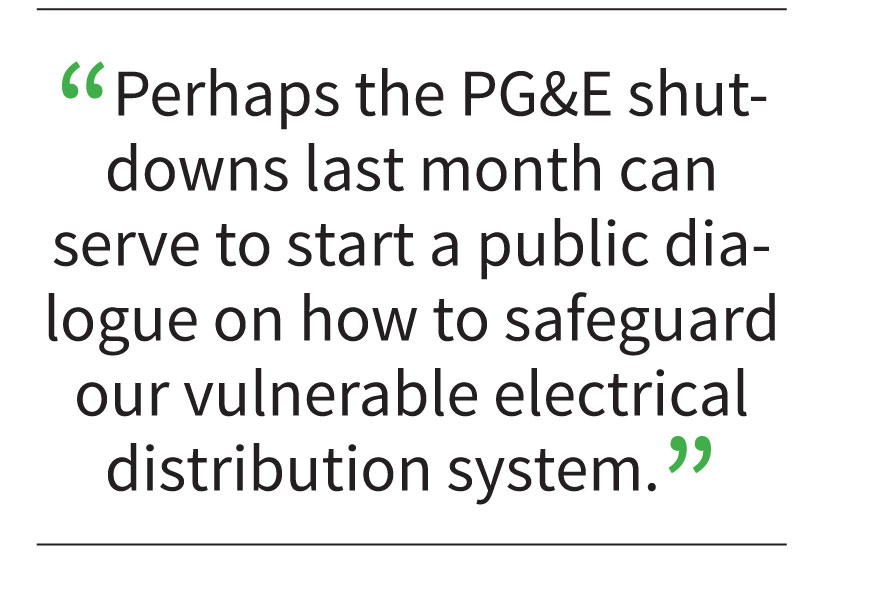South Valley residents face recent outages with frustration
Opinion of Morgan Hill Life

PG&E’s “surgical” power shutdowns that inconvenienced millions of customers in several incidents the past two months serve as a reminder that the quality of life Morgan Hill residents enjoy is highly dependent on electricity continuously passing through the transmission lines. The utility conducted the power shutdowns with very little notice, giving the public only a day or two to prepare. People feared facing as many as seven days without power, a possibility PG&E warned about but which never happened.
 We hope these shutdowns are not going to become the “new normal” during California’s fire season. We wonder if it’s necessary for PG&E to cause hundreds of thousands to face power outage hardship, including a financial hit from lost business, instead of properly maintaining its lines to prevent wildfires.
We hope these shutdowns are not going to become the “new normal” during California’s fire season. We wonder if it’s necessary for PG&E to cause hundreds of thousands to face power outage hardship, including a financial hit from lost business, instead of properly maintaining its lines to prevent wildfires.
South Valley residents faced the recent outages with frustration. Many found themselves for several days without electricity. The Morgan Hill police enforced an after-dark curfew in blacked-out areas to try to prevent looting and vandalism.
Many Americans fail to realize that one of our biggest national security threats is the vulnerability of our power distribution system. In March of this year, hackers made the first officially-recognized cyberattack on the U.S. grid, hitting blind spots at a control center as well as several small power generation sites in western states. Although it did not cause any blackouts and it is not known if it was a specifically targeted attack, experts consider it an unprecedented event.
Political leaders would be smart to take this as a warning. We must better guard our nation’s energy flow, especially with the knowledge that Russia and other countries continue to probe our power grid’s IT systems for weaknesses they can use to bring the entire system down in less than an hour.
A major cyberattack taking down the entire power grid is just one scenario. The nightmare could also be caused by a large electromagnetic pulse or a major geomagnetic storm from a solar flare damaging the grid’s vulnerable hardware. If it brings down the entire grid for many months, according to national security experts as many as 9 out of 10 people in the U.S. could die in the aftermath. That’s 300 million Americans.

In his testimony to the U.S. Senate Committee on Homeland Security & Governmental Affairs in 2015, James Woosley, a former director of the CIA, was asked what would happen if the electrical grid went down for a year or two, following a cyberattack or other cause. He based his answer on a commissioned report from 2008:
“There are essentially two estimates on how many people would die from hunger, from starvation, from lack of water, and from social disruption,” he said. “One estimate is that within a year or so, two-thirds of the United States population would die. The other estimate is that within a year or so, 90 percent of the U.S. population would die. We’re talking about total devastation. We’re not talking about just a regular catastrophe.”
The intense weather caused by climate change would contribute to the deaths. People vulnerable to heat, such as babies and the elderly, would perish in heat waves if there was no power to run air-conditioning. Law and order would break down in communities as people grew hungry from lack of food if farms could not produce it or trucks could not deliver it.
 Most of our modern-day commerce so reliant on electricity would cease to exist. Communications will shut down, adding to the chaos as people cannot get information about the disaster. For a few days after the power goes out, people will have running water. But that supply will run out quickly.
Most of our modern-day commerce so reliant on electricity would cease to exist. Communications will shut down, adding to the chaos as people cannot get information about the disaster. For a few days after the power goes out, people will have running water. But that supply will run out quickly.
Perhaps the recent PG&E power shutdowns can serve to start a public dialogue on how to safeguard our vulnerable electrical distribution system.
One consideration local leaders might want to consider is encouraging the development of micro-grids in communities.
Another is the development of local power from solar, wind, and other non-fossil fuel sources. The threat of PG&E outages we face in the future means we encourage you to keep your homes stocked with food, water and other supplies for an outage.






